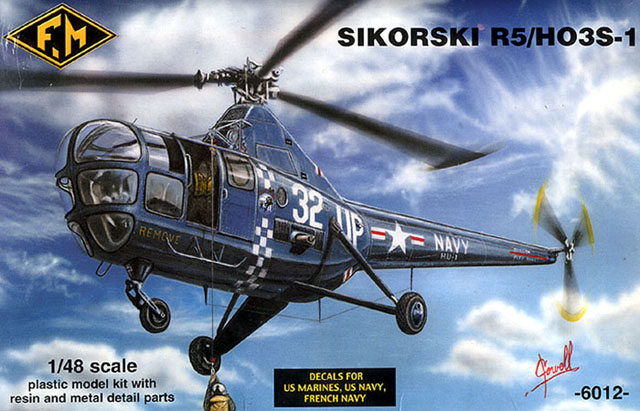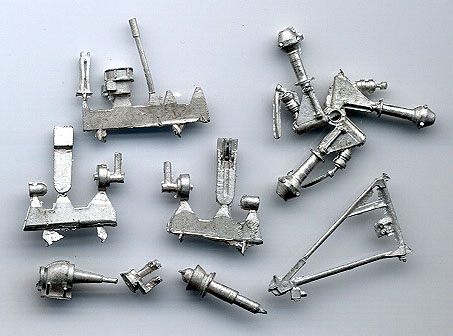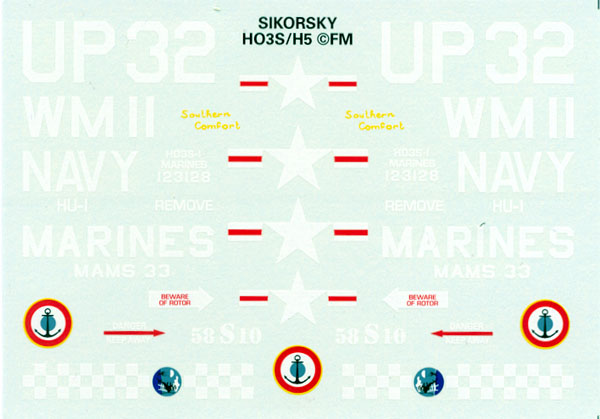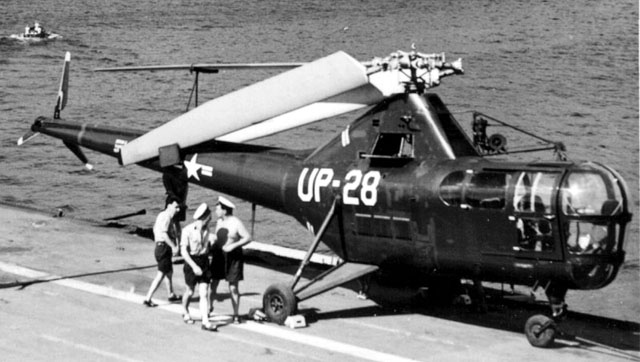|
Sikorsky HO3S-1/R5

Fonderie Miniature
S
u m m a r y
|
| Catalogue No. &
Description |
6012 |
| Price: |
USD$33.96
from Squadron.com |
| Contents and Media: |
45 injection moulded pieces; one
resin cast piece; 1 sprue of etched brass with 19 pieces; 12 white metal
pieces; decal sheet |
| Scale: |
1/48 |
| Review Type: |
FirstLook |
| Advantages: |
Clever moulding of clear fuselage
simplifies big, curved windows; excellent use of multi-media;
well-detailed and complete |
| Disadvantages: |
Textured surface on some parts,
including fuselage halves |
| Recommendation: |
Recommended |
Reviewed by
Rodger Kelly

FM's 1/48 Scale
R5/HO3S-1 Helicopter is available online from
Squadron.com
Fonderie Miniature, or as it is more commonly known, FM, is a French
company that produces mixed-media, limited run kits of subjects that are
unlikely to ever be released by the main-line companies.
One of their latest efforts in 1/48 scale is the Sikorsky HO3S-1/R5, an
early helicopter that saw a great degree of service with various countries
including the US, France and Japan.
So what do you get for your money? Lots! The kit comprises of 45 injection
moulded pieces; one resin cast piece, a sprue of etched brass with 19
pieces, 12 white metal pieces and a decal sheet that gives markings for
three different machines.
The injection moulded pieces come on three different sprues. The parts are
well formed and well detailed. Flash is at a minimum as can be expected in
a limited run kit and there is a complete absence of sink-holes. The sprue
containing the rotor blades exhibits a slight grain to the surface of the
parts but this is not too excessive and I doubt that it will even be
noticed once the parts are painted. The trailing edges of the main and
tail rotors are acceptably thin but the purist will want to thin them down
a little more, again, the thickness of these parts is a product of the
process of manufacture. Whilst speaking about the blades, they are moulded
“flat” and the modeller will have to introduce the droop that the real
machines display.
The sprue that carries the fuselage halves and the nose is formed in clear
plastic. I for one am happy that FM have gone this route as it completely
does away with the problem of having to fit windows with rounded edges
into a fuselage with compound curves. The fuselage halves do not join
across any of the windows and the nose joins on at a panel line so there
will not be a problem with eliminating the join line. Simple! All you have
to do is mask off the windows and paint away! A good engineering choice by
FM – thank you! The same grainy surface as the rotor blades is also
present on the fuselage. Strangely, the graininess is only present on the
“aluminium” of the fuselage and not on any of the windows. The latter are
clear and shiny. Again, this should not detract from the finished model as
the majority of these machines were painted in an overall Glossy Sea Blue
(Gloss Sea Blue) paint scheme.
Click the thumbnails below
to view larger images:
The etched metal sprue is mercifully presented in brass, which is a lot
easier to bend than stainless steel! All of the parts are well detailed
and exhibit etched relief, the bezels on the instrument panel being an
example. Part 14 is the grill that fits over the air intake and it is a
joy to behold as it faithfully reproduces the matrix of the full-sized
machines.
The kit’s single cast resin piece is the plinth on which the instrument
panel is mounted (I forgot to scan an image of this piece but rest assured
that it is up to the same standard as the rest of the pieces).
The white metal detail pieces are superbly cast and have very little
flash. The casting of the main rotor hub in white metal was a good choice
by FM as it will bear the weight of the three bladed rotor much more
effectively than a plastic piece.

The decal sheet supplies options for three different machines all finished
in Gloss Sea Blue:
-
A US Navy machine from HU-1 aboard USS
Bataan in 1952. This is probably the best option to break up the overall
Gloss Sea Blue finish as it exhibits a white checkerboard band around
the fuselage, which incorporates the squadron patch and large white
Airwing Identifier/modex number.
-
A USMC machine of MAMS-33 that operated
over the Sea of Japan between 1950 and 1953. Basic markings as for the
above machine but this aircraft has the rear of the tailboom painted in
orange and sports the name “Southern Comfort” in yellow on the nose.
-
The final markings option is for a French
machine of Flotille 58S aboard the carrier Arromanches whilst it was
deployed off the coast of Vietnam during the period 1953 to 1952. Pretty
simple markings here as it only sports French Navy roundels and a white
serial number on the nose.
The decals themselves are semi-gloss and sharply printed. There are no
register problems on the sheet. The thin yellow band around the outer edge
of the French Navy roundels is perfect and the red of the US Navy’s stars
and bars is positioned perfectly in the centre of the bars where it is
supposed to be. Whilst the decals appear to be excellent the true test to
their opaqueness will come when they are applied to the dark Gloss Sea
Blue!

The double-sided, A4 instruction sheet provides a potted history of the
machine in both French and English. The assembly drawings are sharp and
clear and give an exploded view of the assembly sequence and offer
assembly and detail advice throughout.
The markings instruction sheet is confined to line drawings which give
adequate information as to the placement of the decals and to the colour
scheme of each machine. Simple yet adequate. The sheet also shows a JSDF
machine but the notes state that these markings are only supplied in those
kits destined to be exported to Japan.
Click the thumbnails below
to view larger images:
Dry fitting of the major components reveals that the majority of your work
will be confined to the completion of the detail parts and to the paint
scheme.
This kit and has enabled me to complete my Korean War collection of
Royal Australian Navy (RAN) aircraft. My father was a young sailor during
the Korean War and was aboard the carrier HMAS Sydney on both of her tours
during the conflict. He was a radar rating and as such was able to spend
time above deck on what the RAN called “Goofer’s Gallery” – the US Navy
equivalent is Vulture’s Row. He used to tell me all about the noise and
spectacle of the launch and recovery operations and of the US Navy
helicopter that the ship had on loan to them to act as their “Plane
Guard”. That helicopter was a Sikorsky HO3S-1. Its call-sign was “Shine
Angel” and he would relate to me how loud the machine was and that the
pilot was always willing to take joyriders without any fuss. I have
included a couple of his photos to illustrate that machine.

Click the thumbnails below
to view larger images:
Reference on this machine is not all that hard to come by and simply
typing “Sikorsky HO3S-1/R5” into your favorite search engine will deliver
enough matches to keep you happily “engaged in research” when you should
be doing other things.
A perfect reference is the movie “The Bridges at Toko-Ri” for it is a
Sikorsky HO3S-1 in which Mickey Rooney happily navigates around the sky
whilst wearing his green top hat and scarf! By simply freeze-framing the
video you will be able to gather info on the interior and exterior details
as well as the bonus of getting information on the interior colour.
In conclusion, this is a great kit. Mine is destined to replicate
“Shine Angel” and be parked next to my Hobbycraft Sea Fury and up-coming
Grand Phoenix Mk V Firefly but my bet is that quite a few of them will be
completed with a 1/48 scale top hat gracing the pilot’s seat.
Recommended.
Review Copyright © 2002 by Rodger
Kelly
Page Created 10 April, 2002
Last updated 22 July, 2003
Back to HyperScale
Main Page
Back to Reviews
Page
|
Home | What's
New | Features
| Gallery |
Reviews | Reference
| Forum
| Search